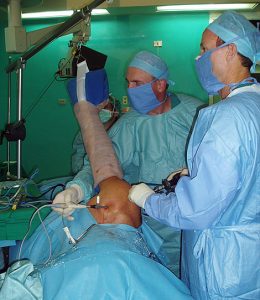Shoulder arthroscopy can be performed for many conditions of the shoulder. Shoulder impingement, rotator cuff tears, instability and labral problems can all be addressed using the arthroscope. The surgery involves the insertion of a camera into joint (arthro = joint, scopy = camera). This generally decreases the amount of pain and incision size. The surgeon can often visualize the shoulder better with the scope than through an open incision.
What should I do before surgery?
Patients should optimize their health to prepare for surgery. Any heart, lung, kidney, bladder, tooth, or gum problems should be managed before the shoulder surgery. Any active infections will delay elective surgery to optimize the benefit and reduce the risk of shoulder joint infection. The surgeon should be made aware of any health issues, including allergies and non-prescription and prescription medications being taken. Some medications will need to be held or stopped prior to surgery. For instance, aspirin and anti-inflammatory medications (Advil®, Motrin®, Alleve®, and other NSAIDs) should be discontinued at least 7 days prior to surgery as they will affect intra-operative and postoperative bleeding.
Patients must plan on being less active and functional for 12 to 16 weeks after the surgery. Driving, shopping and performing overhead chores, lifting, and repetitive arm activities may be difficult or impossible during this time. Plans for the necessary assistance need to be made before surgery. For individuals who live alone or those without readily-available help, arrangements for home help should be made well in advance.
What is surgery like?
 Surgery is usually performed at an outpatient surgery center. The actual surgery takes approximately 2 hours. You are able to return home approximately 1 to 2 hours after surgery. The operation is performed arthroscopically through 2 to 3 small “portals” (5 mm incisions). A portal is placed in the back of the shoulder for the camera. One to two portals are placed on the top of the shoulder for the instruments. If there is a spur present, a shaver and a burr will be used to remove approximately 5 mm of bone. Tendon and labrum tears are repaired using anchors. Anchors with sutures attached are inserted into the humeral head and used to re-attach the tendon back to the bone.
Surgery is usually performed at an outpatient surgery center. The actual surgery takes approximately 2 hours. You are able to return home approximately 1 to 2 hours after surgery. The operation is performed arthroscopically through 2 to 3 small “portals” (5 mm incisions). A portal is placed in the back of the shoulder for the camera. One to two portals are placed on the top of the shoulder for the instruments. If there is a spur present, a shaver and a burr will be used to remove approximately 5 mm of bone. Tendon and labrum tears are repaired using anchors. Anchors with sutures attached are inserted into the humeral head and used to re-attach the tendon back to the bone.
What is it like after surgery?
The actual surgery takes approximately 2 hours. You are able to return home approximately 1 to 2 hours after surgery. You are placed into a shoulder sling for the first few days. Pain medication and ice are usually required for the first week after surgery. You will return to the office in 7 to 10 days to have the sutures removed. We then begin a course of physical therapy emphasizing motion for the first 6 weeks. Therapy is generally required for 12 weeks after surgery.
